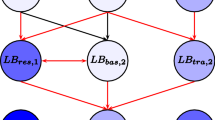Abstract
A new zero-one integer programming model for the job shop scheduling problem with minimum makespan criterion is presented. The algorithm consists of two parts: (a) a branch and bound parametric linear programming code for solving the job shop problem with fixed completion time; (b) a problem expanding algorithm for finding the optimal completion time. Computational experience for problems having up to thirty-six operations is presented. The largest problem solved was limited by memory space, not computation time. Efforts are under way to improve the efficiency of the algorithm and to reduce its memory requirements.
Similar content being viewed by others
References
K.R. Baker,Introduction to Sequencing and Scheduling (Wiley, New York, 1974).
E. Balas, Machine sequencing via disjunction graphs: An implicit enumeration algorithm, Operations Research 17(1969)941.
E. Balas, Disjunctive programming and a hierarchy of relaxations for discrete optimization problems, Management Science Research Report MSRR 492, Carnegie-Mellon University (19).
R. Bellman, A.E. Esogbue and I. Nabeshima, International Series in Modern Applied Mathematics and Computer Science, Vol. 4:Mathematical Aspects of Scheduling and Applications (Pergamon Press, Oxford, 1982).
E.H. Bowman, The scheduling sequencing problem, Operations Research 7, 5(1959)621.
R.W. Conway, W.L. Maxwell and L.W. Miller,Theory of Scheduling (Addison Wesley, Reading, Mass., 1967).
S. French,Sequencing and Scheduling: An Introduction to the Mathematics of the Job Shop (Ellis Horwood Ltd., Chichester, England, 1982).
M.R. Garey and D.S. Johnson,Computers and Intractibility: A Guide to the Theory of NP Completeness (Freeman, 1979).
J.K. Lenstra,Sequencing by Enumeration Methods, Mathematical Center Tract 67 (Mathematisch Centrum, Amsterdam, 1974).
A.S. Manne, On the job shop scheduling problem, Operations Research 8, 2(1969)219.
J.F. Muth and G.L. Thompson, eds.,Industrial Scheduling (Prentice Hall Inc., Englewood Cliffs, New Jersey, 1963).
L. Nemeti, Das reihenfolge problem in der fertigungsprogrammierung und linearplanung mit logischen bedingungen, Mathematika 6, 29(1964)87.
A.A.B. Pritsker, L.J. Watters and P.M. Wolfe, Multiproject scheduling with limited resources: A zero-one programming approach, Management Science 16(1969)93.
A.P. Sethi and G.L. Thompson, The Pivot and Probe Algorithm for solving a linear program, Mathematical Programming 29(1984)219.
A.E. Story and H.M. Wagner, Computational experience with integer programming for job shop scheduling, in: [11], pp. 207–219.
H.M. Wagner, An integer linear programming model for machine scheduling, Naval Research Logistics Quarterly 6, 2(1959)131.
Author information
Authors and Affiliations
Additional information
This report was prepared as part of the activities of the Management Sciences Research Group, Carnegie-Mellon University, under Contract No. N00014-82-K-0329 NR 047-048 with the U.S. Office of Naval Research. Reproduction in whole or in part is permitted for any purpose of the U.S. Government.
Rights and permissions
About this article
Cite this article
Thompson, G.L., Zawack, D.J. A problem expanding parametric programming method for solving the job shop scheduling problem. Ann Oper Res 4, 327–342 (1985). https://doi.org/10.1007/BF02022046
Issue Date:
DOI: https://doi.org/10.1007/BF02022046




